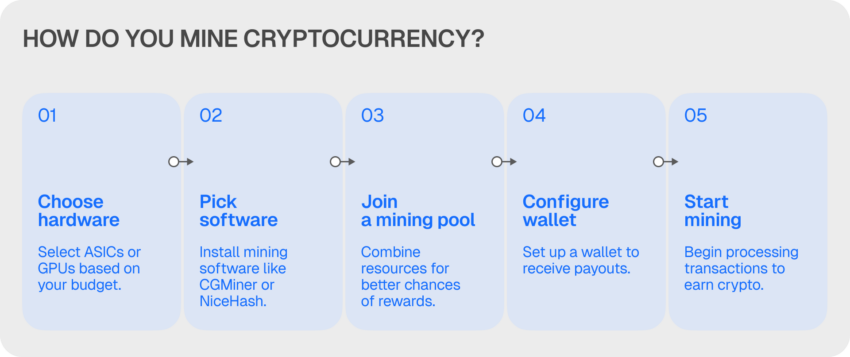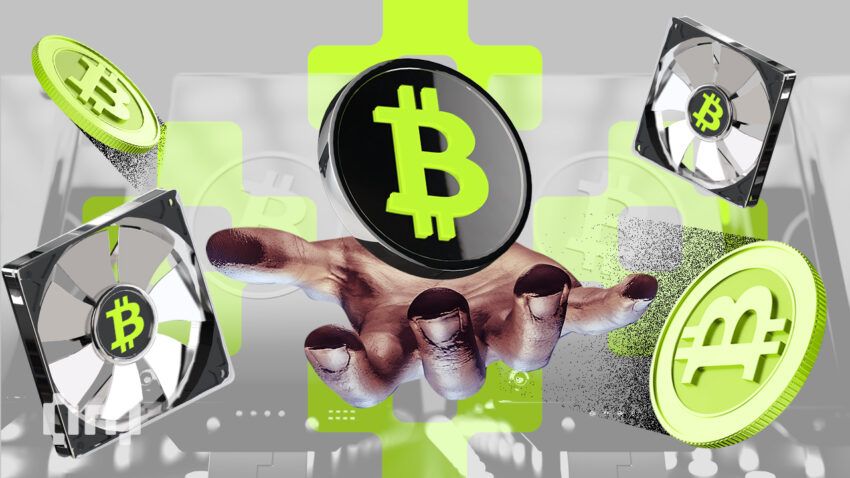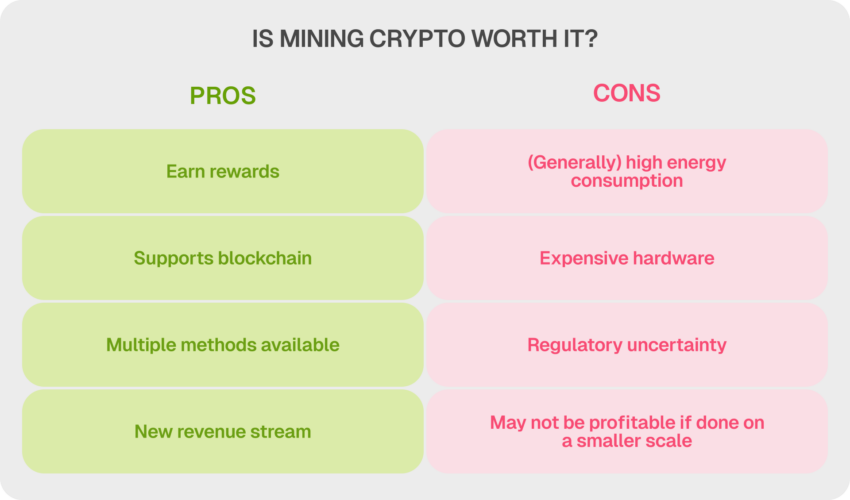Cryptocurrency mining has become increasingly popular in recent years, with many people looking to profit by mining coins. In this article, we look at how to mine cryptocurrency and the best mining algorithms. Whether you’re a beginner or an experienced miner, read on to learn everything you need about mining cryptocurrency.
How do you mine cryptocurrency?

Crypto mining can be a source of passive income. However, there are different methods and processes for mining and creating cryptocurrency.
Before starting to mine crypto, one must research all the costs of the chosen mining process before determining the potential profit. Despite its potential rewards, mining may prove challenging and yield inconsistent profits due to fluctuating crypto prices and energy costs. To maximize success, it’s important to properly configure the mining devices and invest additional funds to keep running an operation smoothly.
Here is a step-by-step guide on how to mine cryptocurrency. This will help you start mining independently, but these general steps may not be suitable for all methods.
1. Choose your cryptocurrency
Cryptocurrencies have varying mining difficulties, which is the amount of effort needed to mine a block. Competition increases as more miners join the network, increasing hashing difficulty. Conversely, when miners leave the network, the hashing difficulty decreases, making it easier to mine new blocks.
However, mining conditions are extremely tough for large cryptocurrencies like Bitcoin, making it difficult for individual miners to earn revenue. That’s why it’s common for Bitcoin miners to invest in powerful ASICs and join mining pools to increase their chances of getting rewarded.
Other proof-of-work (PoW) coins that may represent a good option for crypto miners are Dogecoin and Ethereum Classic. The main reason smaller miners might choose altcoin networks is that they are less congested. Furthermore, altcoins may have greater growth potential due to their untapped resources. At the same time, altcoin mining requires less energy consumption since there’s not as much needed computational power.
The downside when mining altcoins is their highly volatile prices. In the worst-case scenario, the protocol could get hacked or abandoned, leaving your tokens worthless. Certain cryptos have become more sought-after, so you may need to upgrade your mining rigs and spend more money than expected.
2. Choose your mining equipment
Cryptocurrency mining is a form of competition, and miners benefit from having powerful mining hardware as it increases their chances of finding the next block.
ASIC miners are generally the best option for cryptocurrency mining as they are specifically designed for this task. However, depending on the cryptocurrency’s difficulty and algorithm, GPUs may still be effective on certain networks.
Certain cryptocurrencies, such as those mined with Helium’s radio technology, need specific mining equipment. These devices must be situated in areas with clear, unrestricted access to wireless networks for effective operation. As a result, it’s important to verify that you possess the appropriate hardware required for mining the cryptocurrency you’ve selected.
3. Create a crypto wallet

You’ll need a crypto wallet to receive your rewards when mining cryptocurrency. Some solid non-custodial crypto wallets on the market include Coinbase and Nexo.
Ledger, Trezor, and Safepal are all good hardware wallet options.
Once your wallet is set up, you can generate an address to receive and store your digital coins.
4. Configure your crypto miner device
To mine cryptocurrency, you’ll need to download specialized mining software. The most convenient way to access the software is through the official website of the crypto you intend to mine; this guarantees the correct version and helps prevent fraudulent programs.
Most mining software is free to download and use. Many cryptos have multiple software options for various operating systems. Doing Your Own Research (DYOR) before selecting one mining software is always wise.
Establishing a strategy to monitor electricity costs is another necessary component of setting up a mining device. Begin by reviewing past bills and estimating the cost of mining. Unfortunately, due to the high energy consumption from mining rigs, you may spend more on energy than you earn.
It is essential to remember that mining rigs can be noisy and generate heat. Therefore, consider placing them in a secure area with adequate cooling. It might also be a good idea to put them in a place that will not keep anyone awake at night.
5. Join a mining pool
Individual miners have had a slim chance of success. Only one block is mined at a time, and the reward goes to the first miner who finds the correct hash. Despite several powerful ASICs, your share of Bitcoin’s overall hashing power remains small.
Mining pools combine the computing power of many participants to increase the odds of discovering the next block. By joining a mining pool and pooling your hashing power, you could earn more money than if you were mining alone.
Mining pools typically employ a coordinator to organize their miners, thus minimizing the likelihood of mistakes. When the mining pool discovers a new block, they split the rewards between the participants according to their mining power. Usually, mining pools have a small fee, which is subtracted from the reward.
What is crypto mining?

Cryptocurrency mining validates transactions and adds new blocks to a proof-of-work (PoW) blockchain network, such as Bitcoin. Miners carry out this process. These are powerful computer hardware to solve complex mathematical equations and earn cryptocurrency units as compensation.
Miners compete with each other to solve equations. The first miner who solves an equation and adds a new block to the blockchain is rewarded with new units of cryptocurrency, which can then be sold or held as an investment.
Mining is an integral component of the cryptocurrency ecosystem, helping to protect and bolster its integrity. It also allows individuals to participate in the market and profit by contributing computing power.
Unfortunately, mining can be expensive due to the technical knowledge required and the costs of investing in hardware and electricity.
Types of cryptocurrency mining

Crypto mining can be conducted through several methods, including CPU, GPU, FPGA, ASIC, and cloud mining, each leveraging different technologies for solving complex mathematical problems.
These approaches range from personal computer processors and graphics cards to specialized hardware and remote data center resources, catering to various levels of investment and expertise.
CPU mining
A CPU (central processing unit) is an electronic component that provides processing power for software installed on computers.
CPU mining software such as CPU Miner was once effective for hash rates of 10MH/sec (MegaHashes per second). Unfortunately, due to Bitcoin’s high hash rate, CPU mining became unprofitable. However, some cryptos, such as Monero (XMR), can still use CPU mining.
Building a CPU mining rig requires key components such as a high-frequency competition processor, sufficient RAM (random-access memory) to support memory channels and bandwidth, a reliable power source, and a motherboard that ensures smooth communication among all the components. Additionally, an air conditioner is crucial to keep the system cool. For CPU mining, individuals can mine solo or enhance their chances of success by joining a mining pool.
Solo miners’ ability to add coins to their wallets depends on the hardware and network hash rates. Before beginning solo mining operations, you must consider the revenue potential against electricity costs and other expenses.
GPU mining
Due to the increasing demand for computational power, CPU mining could not keep up. That’s why graphics processing units (GPUs) have also been used, alongside CPUs, for mining cryptocurrencies.
GPUs were first utilized for bitcoin mining in October 2010 when mining software for GPUs became available online.
Over time, this software has been improved and modified for use in various open-source projects. Modern GPUs offer significantly greater performance than 20 KH/s (kilo hashes), with some providing up to 2,000 times the hashing power.
Furthermore, GPU miners can handle multiple operations in parallel, and some utilize multi-GPU mining rigs for increased output power or hash rates and payouts. Today, you may use GPU mining to mine coins such as Ravencoin (RVN) or Grin (GRIN).
FPGA mining
One of the biggest concerns of cryptocurrency mining is the cost of the mining equipment. Consequently, GPU mining became inefficient due to its high mining costs. This led to a need for machines that could make mining profitable. And field-programmable gate array (FPGA) machines are one solution.
A field-programmable gate array (FPGA) is an electrical circuit that can be programmed to perform specific logical operations and configured to mine a specific cryptocurrency. FPGA miners were less energy-intensive than GPUs, with a break-even cost within two to three years.
FPGAs are unbeatably fast when it comes to performing hashing calculations compared to any other hardware, with the fastest reaching 25,000 MH/s. Regarding efficiency, FPGAs outpace both CPUs and GPUs when performing these calculations; plus, they require less electricity per hashing unit.
However, the popularity of FPGA mining was short-lived due to the arrival of ASICs, which offer a better ratio between cost and energy efficiency. Furthermore, high-volume GPUs running on more sophisticated process nodes proved more expensive per GH/s than FPGAs could offer.
ASIC mining
ASIC stands for “Application-Specific Integrated Circuit,” which is a type of chip created for a specific task.
In the context of crypto, an ASIC miner is a specialized device that employs ASICs to mine proof-of-work (PoW) digital currencies exclusively. These ASIC devices are specifically designed to provide superior performance on large-scale mining operations.
Installing an ASIC miner requires a power supply, followed by internet access, access router, IP address, wallet, and mining pool.
ASIC-based mining has dramatically increased the total hash rate of the Bitcoin network, making it unprofitable to mine with CPUs or GPUs.
Unfortunately, there are a few downsides to ASIC mining. The first one is the high barrier to entry because of the high cost of the mining equipment.
Another downside of ASIC mining is that organizations that possess and maintain many ASIC systems could gain control of the blockchain network. This leaves ASIC-based mining more vulnerable to a 51% attack.
Also, only Bitmain produces ASIC devices. The manufacturer pre-loads them with an application that allows them to manage the device’s hashing power remotely.
Cloud mining
Cloud mining offers individuals a chance to generate cryptocurrency without investing in or maintaining specialized hardware or software.
This mining solution is a method where miners rent an ASIC machine instead of buying one. Miners pay monthly rental fees, and this scheme offers more accessibility when cryptocurrency prices decline or network mining difficulty increases.
Cloud mining can drastically reduce the cost of hardware and software maintenance for businesses. For many, cloud mining offers an ideal chance for those interested in mining without making a significant upfront investment.
How to start cloud mining
ECOS is a leading cloud mining provider that was established in 2017. The platform has over 90,000 users worldwide. They offer a minimum mining contract of $150, a convenient calculator, and a detailed transaction history. ECOS also offers additional services such as a wallet, exchange, investment portfolios, and savings.
Is crypto mining legal?

Crypto mining is legal in most countries. However, its legality may vary from country to country. But generally speaking, if Bitcoin is legal, so is crypto mining.
In some places, crypto mining may even be encouraged. You must research and comprehend the laws in your location before learning how to mine cryptocurrency. Furthermore, certain cryptocurrencies may have specific rules or mining requirements that should be considered before beginning.
Best platforms to mine cryptocurrency
If you are going to mine cryptocurrency, you will need a trusted platform. Be careful; many malicious platforms will cryptojack your computer and other devices. Here are a few trusted platforms for you to begin your mining journey.
1. Hashing24
Hashing24 is a cryptocurrency cloud mining platform. It allows consumers to mine Bitcoin by purchasing hash power from BitFury, an industrial mining equipment seller. With data centers in Canada, Norway, Iceland, and Georgia, Hashing24 allows you to mine Bitcoin without purchasing equipment.
2. YouHodler
With its cloud miner simulator, YouHodler provides a gamified method of mining Bitcoins without requiring additional hardware or incurring fees because it’s all part of their rewards and loyalty program.
One of YouHodler’s distinctive features is its cryptocurrency mining simulator and reward system, which incentivizes users to finish easy tasks.
3. GoMining
Unlike most of its competitors, the Bitcoin mining platform GoMining is unique. By purchasing a virtual miner from GoMining, consumers can sell their NFT on the secondary market and receive an NFT that guarantees daily mining payouts.
Is mining crypto worth it?

When mining cryptocurrency, factors like price, performance, design, and implementation of mining machines all affect profitability. ASICs have become the benchmark when it comes to bitcoin mining due to their superior performance over other machines. However, their longevity against increasing mining difficulty and improving machines remains uncertain.
That’s why you have to think about the budget for investing in crypto mining equipment. Or perhaps you want to choose a cloud mining solution such as ECOS. Laptop GPUs are typically less powerful and more expensive than desktop counterparts, making effective crypto-mining equipment necessary to make a profit from mining.
Remember that cryptocurrency mining requires a great deal of computational energy. The high energy consumption generates a lot of heat, which could eventually damage laptop fans due to the excessive strain placed on them during mining operations.
What’s the future of crypto mining?
Mining cryptocurrency is not just a fun and exciting way to be a part of the crypto world; it’s also a crucial aspect of keeping the blockchain secure and functional. Knowing how to mine cryptocurrency is only one piece of the puzzle. The next is to calculate the potential reward and the costs of maintaining your hardware and electricity bills.
Yes, costs and risks are involved, and you need some technical knowledge, but don’t let that discourage you. With some research and effort, anyone can start mining cryptocurrency and potentially earn some rewards. Just remember to stay updated on the latest developments in the crypto space. Any new updates may greatly impact the mining process.
Frequently asked questions
While it is technically possible to mine some cryptocurrencies on a smartphone, it may not be practical or profitable. Smartphones do not have enough processing power to compete with dedicated mining equipment such as ASICs, GPUs, or even CPUs. Additionally, mining on the phone can quickly drain the battery and cause the device to overheat, potentially damaging it. Therefore, if you’re looking for how to mine cryptocurrency on your phone, know that it is possible. But it is not recommended or reliable for mining cryptocurrency.
Yes, you can mine cryptocurrency at home. But it’s important to consider the costs and risks associated with it. Mining cryptocurrency requires a certain degree of technical knowledge, especially when acquiring and setting up your physical mining equipment. You will also need to consider the electricity costs and the potential returns from mining. In addition, it’s important to do your own research and understand the specifics of the cryptocurrency you want to mine, as well as set up a crypto wallet to receive potential mining rewards.
Yes, there are taxes on cryptocurrency mining. In most countries, mining cryptocurrency is considered a business, and crypto mining profits are subject to taxation. The tax laws regarding crypto mining vary from country to country, so it’s essential to consult with a tax professional or accountant to understand the specific regulations in your jurisdiction.
Mining cryptocurrency requires a significant amount of energy. This can have a negative impact on the environment. The high electricity usage may result in increased carbon dioxide emissions and, consequently, environmental pollution. The carbon footprint of mining can be minimized by utilizing renewable energy sources, such as wind or solar power.
Yes, you can mine cryptocurrency on your laptop. However, it may not be the most efficient or profitable way to mine cryptocurrency. Laptops are not designed for the high-intensity processing required for mining, and their graphics processing units (GPUs) are typically less powerful than those in desktop computers. The heat generated during the mining process may also damage a laptop’s internal components and reduce its lifespan.
Disclaimer
In line with the Trust Project guidelines, the educational content on this website is offered in good faith and for general information purposes only. BeInCrypto prioritizes providing high-quality information, taking the time to research and create informative content for readers. While partners may reward the company with commissions for placements in articles, these commissions do not influence the unbiased, honest, and helpful content creation process. Any action taken by the reader based on this information is strictly at their own risk. Please note that our Terms and Conditions, Privacy Policy, and Disclaimers have been updated.







